
Basidiomycota is one of two large divisions that, together with the Ascomycota, constitute the subkingdom Dikarya within the kingdom Fungi. Members are known as basidiomycetes. More specifically, Basidiomycota includes these groups: agarics, puffballs, stinkhorns, bracket fungi, other polypores, jelly fungi, boletes, chanterelles, earth stars, smuts, bunts, rusts, mirror yeasts, and Cryptococcus, the human pathogenic yeast.

Corn smut is a plant disease caused by the pathogenic fungus Ustilago maydis. One of several cereal crop pathogens called smut, the fungus forms galls on all above-ground parts of corn species such as maize and teosinte. The infected corn is edible; in Mexico, it is considered a delicacy called huitlacoche, often eaten as a filling in quesadillas and other tortilla-based foods, as well as in soups.
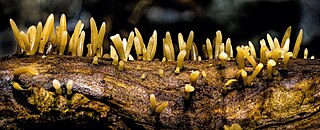
Heterobasidiomycetes, including jelly fungi, smuts and rusts, are basidiomycetes with septate basidia. This contrasts them to homobasidiomycetes, including most mushrooms and other Agaricomycetes, which have aseptate basidia. The division of all basidiomycetes between these two groups has been influential in fungal taxonomy, and is still used informally, but it is no longer the basis of formal classification. In modern taxonomy homobasidiomycetes roughly correspond to the monophyletic class Agaricomycetes, whereas heterobasidiomycetes are paraphyletic and as such correspond to various taxa from different taxonomic ranks, including the Basidiomycota other than Agaricomycetes and a few basal groups within Agaricomycetes.

Ustilago is a genus of approximately 200 smut fungi, which are parasitic on grasses. 170 species are accepted by Wijayawardene et al. 2020;
Within the cells of some members of basidiomycetes fungi are found microscopic structures called parenthesomes or septal pore caps. They are shaped like parentheses and found on either side of pores in the dolipore septum which separates cells within a hypha. Their function has not been established, and their composition has not been fully elucidated. The variations in their appearance are useful in distinguishing individual species. Generally, they are barrel shaped, with an endoplasmic reticulum covering.

Teliospore is the thick-walled resting spore of some fungi, from which the basidium arises.
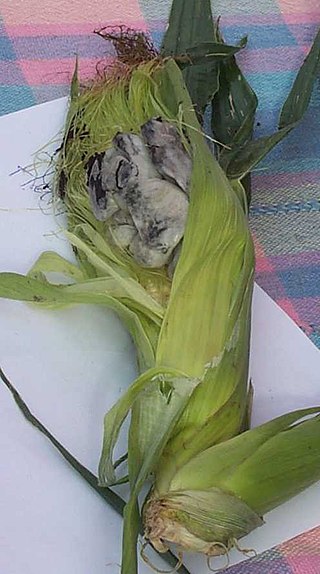
The Ustilaginales are an order of fungi within the class Ustilaginomycetes. The order contained 8 families, 49 genera, and 851 species in 2008.

The Ustilaginomycotina is a subdivision within the division Basidiomycota of the kingdom Fungi. It consists of the classes Ustilaginomycetes and Exobasidiomycetes, and in 2014 the subdivision was reclassified and the two additional classes Malasseziomycetes and Monilielliomycetes added. The name was first published by Doweld in 2001; Bauer and colleagues later published it in 2006 as an isonym. Ustilagomycotina and Agaricomycotina are considered to be sister groups, and they are in turn sister groups to the subdivision Pucciniomycotina.
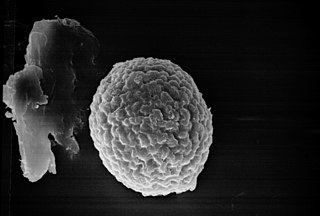
The Tilletiales are an order of smut fungi in the class Exobasidiomycetes. It is a monotypic order, consisting of a single family, the Tilletiaceae, which contains seven genera. The roughly 150 species in the Tilletiales all infect hosts of the grass family, except for species of Erratomyces, which occur on legumes.
The Cintractiellaceae are a monotypic, family of smut fungi, in the order Cintractiellales, but unplaced beyond that. The family contains one genera, Cintractiella with 4 species. The family was circumscribed by mycologist Kálmán Vánky in 2003.
The Websdaneaceae are a family of smut fungi in the class Ustilaginomycetes. Collectively, the family contains 2 genera and 22 species.
The Uleiellaceae are a family of smut fungi in the order Ustilaginomycetes. The family contains the single genus Uleiella, which has two species.
The Melanotaeniaceae are a family of smut fungi in the order Ustilaginomycetes, containing three genera.
The Exoteliospora is a monotypic, genus of smut fungi in the family Melanotaeniaceae which contains the single species Exoteliospora osmundae.
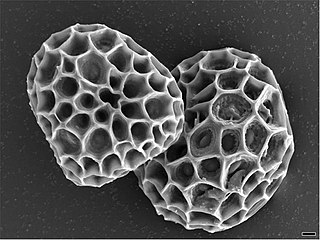
Bauerago is a genus of fungi found in the family Microbotryaceae. It contained 9 species before being reduced to 5 species.
Robert Bauer was a German mycologist, specialising in rust (Uredinales) and smut (Ustilaginomycetes) fungi.
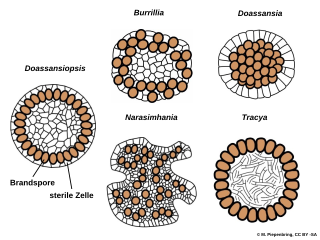
Doassansiopsis is a genus of smut fungi belonging to the monotypic family DoassansiopsidaceaeBegerow, R.Bauer & Oberw., 1998, within the class Ustilaginomycetes and order Urocystidales.

The Urocystidales are an order of fungi within the class Ustilaginomycetes. The order contains 6 families and about 400 genera. They are a sister order to Ustilaginales.

The Doassansiaceae are a family of fungi in the division Basidiomycota and order of Doassansiales. The family contains 11 genera and about 58 species. They have a widespread distribution. Doassansiaceae is also known and classified as a smut fungi.
The Melaniellaceae are a family of fungi in the division Basidiomycota and order of Doassansiales. The family contains 1 genera and 2 species. They have a distribution in south and south-east Asia.











